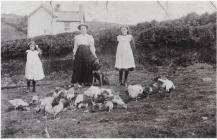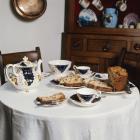Christmas Food
Items in this story:
The goose
Goose has been the festive bird associated with Christmas in Wales over the centuries. As from the late medieval times the yeoman farmer had a goose on his Christmas table. Geese were easily bred and readily fed, especially in the early autumn when they were allowed to glean the fields after the corn harvest. Many farmers would give one as a gift to tenants and workmen to celebrate Michaelmas Day but a fair number would be reserved and fattened for the Christmas Market. In general, the turkey was not accepted as part of the Christmas fare in the rural areas until the second half of this century.
Goose blood tart
In mid-Wales, it was the custom to make goose blood tart when the farmers were killing a large number of geese at Christmastime. Oral evidence testifies that this cake was an essential part of the Christmas fare in the Trefeglwys district and similarly in the districts of Staylittle, Llanbryn Mair and Llangurig in Montgomeryshire. To date, however, there is no evidence to show that it was prepared in any other county in Wales.
The blood of about three geese would be put in a greased basin and boiled in a saucepan half full of water. Then the blood would be allowed to coot and set solid before it was rubbed between the fingers to make fine crumbs. Mixed with currants, flour, suet, salt , spice and golden syrup, it would be baked between two layers of crust on a plate in the oven. A strange mixture of ingredients, you may think, but not unlike the mincemeat in mince pies, which originally included real meat as an ingredient!
Plum Pudding
Plum pudding, well fruited and spiced, has been associated with Christmas since the early 18th century. It would be boiled in one large lump in a linen pudding cloth, a custom that gave it the names lump pudding, rag pudding or bag pudding. The mixture was then bunched together and tied securely with strong cord to form a bag. The bag was then suspended from a stick placed across the top of the cauldron or boiler and immersed in boiling water. It was served with a sweet butter sauce.
Mixing the Christmas pudding involved the whole family when each member, from the youngest to the oldest, would take his turn to stir the pudding and in doing so would cast a secret wish. It was a common custom also when preparing the pudding to put small coins in the mixture - the old silver threepenny or sixpenny pieces, and the lucky recipients on Christmas day regarded them as tokens of good luck.
Toffee Evenings
Noson Gyflaith (Toffee Evening) was a traditional part of Christmas or New Year festivities in some areas of north Wales earlier this century. Families, in their turn, would invite friends to their homes for supper, usually in the form of a Christmas dinner, and it would be followed by merriment, playing games, making toffee, and story telling.
When the required ingredients had boiled to a certain degree, the toffee was poured onto a well-greased slate or stone slab. The hearth-stone itself was used for this purpose in some houses. Members of the happy gathering would then cover their hands with butter and attempt to ‘pull’ the toffee while it was still quite warm. It was a skilled art to ‘pull’ and twist the toffee until it became golden yellow in colour. Both the skilled and unskilled would take part – the one being a source of envy, the other a source of banter.
Toffee-making was also practised in parts of south Wales, especially in the coal-mining areas. As far as we know, it was not associated here with a particular festive occasion, but housewives were known to sell it from their homes or on local market stalls. It was known by various names such as taffi, dant, or ‘fanny’, or indeed it could be known by the name of the person who made it, e.g. losin Magws, or losin Ansin bach. Children would buy it – a six inch strip or two ounces for a penny.
Loaf cake
Loaf cake was synonymous with Christmas celebrations in the industrial valleys of south Wales. The dough, prepared in large quantities, would be carried to the local bakehouse where the baker would be responsible for baking the cakes for a penny or two per loaf.
Neighbours were invited to taste each other's cake, and tradition has it (in the district of Margam near Port Talbot) that if a young maid was given the opportunity to taste thirteen different cakes in one season, she would marry before the following Christmas.



